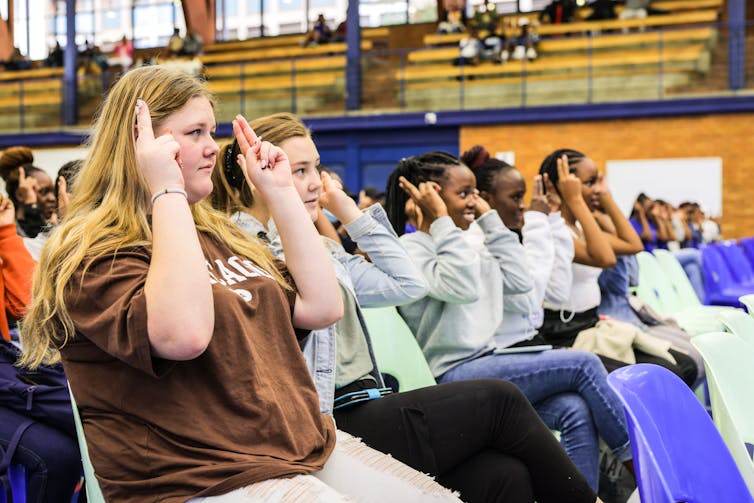
Claudine Storbeck, University of the Witwatersrand
South African Sign Language is now the country’s 12th official language. Parliament approved a constitutional amendment in a bid to “promote the rights of persons who are deaf (sic) and hard of hearing”.
Claudine Storbeck, founder and director of the Wits Centre for Deaf Studies at South Africa’s University of the Witwatersrand, explains what the move could – and should – mean for Deaf education in the country.
What is the educational environment today for Deaf learners in South Africa?
There are 43 schools for the Deaf across the country. Of these, 38 use South African Sign Language (SASL) as the language of teaching and learning. The aim is to ensure that the complete academic curriculum is taught. However, the anecdotal feedback we get from teachers of the Deaf suggests that they are unable to fully complete the curriculum each year and this gap keeps growing.
There isn’t any data on hearing versus Deaf education nor on the number of qualified teachers of the Deaf. We at the Wits Centre for Deaf Studies plan to start such a database soon. We do know that the large majority of teachers in schools for the Deaf are hearing. They are not required to have any form of specialised training or qualification in Deaf education or in SASL before they are appointed. Their signing skills are not evaluated before they are appointed.
In fact, these teachers are not formally required to do SASL courses – only encouraged. In this situation the teachers pick up some SASL from learners as they go along. It’s totally unacceptable that pupils have to become teachers to try to facilitate communication, before they can truly be learners. Teachers’ signing skills are never re-assessed; there are no quality assurance mechanisms in Deaf education in South Africa and ultimately it is the Deaf learners who pay the price.
This situation makes it clear why Deaf learners’ education is sub-par and their literacy levels are low. As with the question of qualified teachers for the Deaf, there is a dearth of data on Deaf school leavers’ literacy levels: the most recently available figures, quoted in a 2012 research article, suggest that
In South Africa as few as one in three Deaf adults who use South African Sign Language (SASL) is functionally literate and the average Deaf school leaver has a written language comprehension ability equal to that of a hearing child of eight.
Will the recognition of SASL as an official language help Deaf education?
The poor quality of Deaf education has a domino effect on post-school opportunities and employment. Previously, training entities – as well as employers – could decline access to SASL interpreting. They could say it wasn’t reasonably practical or it caused an undue burden.
Now that SASL is an official language it must, by law, be properly integrated into the education and post school system.
The constitutional amendment can empower the national department of basic education to make it mandatory for teachers at schools for the Deaf to have specialist qualifications. The department must also strengthen SASL curriculum training and support. This can be done with the help of curriculum and subject specialists at the department as well as at universities. SASL resources need to be expanded along with Deaf education materials, and Deaf learners need to see their own published literature.
There are academic specialists in Deaf education and SASL linguists. But very few are Deaf academics themselves: crucially, Deaf education must be led by the Deaf. Hearing academics who wish to partner on this journey need to be fluent signers and experts within SASL and Deaf education in the South African context.
To reach this point, universities and the department of basic education must prioritise the training of Deaf teachers. This is an historical challenge: Deaf children come through a poor education system and don’t graduate with an equitable school leaving qualification or don’t qualify for university access to train as teachers – a vicious cycle. The proposals I’ve outlined here can help to break this cycle.
The recognition of SASL as an official language is a big step in the right direction. It’s an opportunity for the almost 4 million Deaf people in South Africa (of whom 600,000 are SASL users) to properly access their human rights in a language they understand. That journey must begin in the classroom.
Updated to reflect South African Sign Language becoming an official language on 19 July 2003.![]()
Claudine Storbeck, Professor and Founder of the Wits Centre for Deaf Studies, University of the Witwatersrand
This article is republished from The Conversation under a Creative Commons license. Read the original article.

